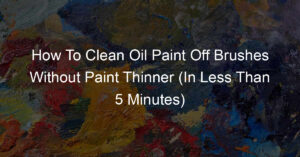As an artist (or an art collector), you may be wondering if you need to seal oil paintings. The short answer is no.
Oil paintings do not need to be sealed because the oil in the paint creates a barrier that prevents the painting from being damaged.
However, there are some things you can do to protect your painting and keep it looking its best. Here are a few tips on how to treat oil paintings:
1. Hang your painting in a cool, dry place.
2. Avoid hanging your painting in direct sunlight.
3. Dust your painting regularly with a soft, dry cloth.
4. If you need to clean your painting, use a mild soap and water solution. Do not use harsh chemicals or abrasive cleaners.
5. If you are storing your painting, wrap it in acid-free paper or storage sleeves made for oil paintings.
By following these simple tips, you can help protect your oil paintings and keep them looking beautiful for years to come (also read about how to protect Oil Painting).
How Do You Protect a Finished Oil Painting?
Once your painting is dry and sealed, you can protect it from damage by framing it. Make sure you use an acid-free mat when framing your painting, and use UV-resistant glass to keep it from fading.
You can also hang your painting out of direct sunlight to prevent it from fading over time.
If you’re not planning on framing your painting, you can still protect it by hanging it in a place where it won’t be exposed to dirt or dust.
You can also put it in a protective sleeve or box when you’re not displaying it.
| Do: | Don’t: |
|---|---|
| Handle with clean hands or wear white cotton gloves. | Touch the painting with dirty or greasy hands. |
| Clean with a soft brush or lint-free cloth. | Use water or harsh chemicals to clean the painting. |
| Store in a dry, cool, and dark place. | Store in a damp, hot, or bright place. |
| Frame the painting to protect it from dust and damage. | Expose the painting to direct sunlight or extreme temperatures. |
Oil paintings can be coated with a varnish, but you don’t have. If you do decide to varnish your painting, make sure you use a non-yellowing varnish, such as Gamvar.
You can apply the varnish with a brush or spray it on, but make sure you do it in a well-ventilated area. Once the varnish is dry, your painting will be protected from dirt and dust.
If you don’t plan on coating your painting with varnish, you can still protect it by framing it. Make sure to use an acid-free mat when framing your painting, and use UV-resistant glass to keep it from fading.
When Should You Seal an Oil Painting?

You should only seal an oil painting if it is completely dry, which can take up to six months.
Applying a varnish too soon can cause your painting to yellow or crack. If you do decide to seal your painting, make sure you use a non-yellowing varnish, such as Gamvar.
You can apply the varnish with a brush or spray it on, but make sure you do it in a well-ventilated area. Once the varnish is dry, your painting will be protected from dirt and dust.
Can I Spray Varnish an Oil Painting?
Yes, you can spray varnish on an oil painting. Make sure you use a non-yellowing varnish, such as Gamvar. Apply the varnish in a well-ventilated area and allow it to dry completely before framing or displaying your painting.
Apart from that, there are a few things you should keep in mind when displaying or storing your oil painting:
- Display your painting in a place where it won’t be exposed to dirt or dust.
- If you’re not framing your painting, put it in a protective sleeve or box when you’re not displaying it.
- Hang your painting out of direct sunlight to prevent it from fading over time.
- Use an acid-free mat when framing your painting, and use UV-resistant glass to keep it from fading.
- You can also put your painting in a frame with UV-resistant glass to keep it from fading.
How Do You Glaze a Finished Oil Painting?
Glazing is a technique that painters use to create a transparent layer of color over an oil painting.
To glaze your painting, you’ll need to mix glazing medium with oil paint. You can buy glazing mediums at most art supply stores.
To apply the glaze, use a soft brush or rag and apply it evenly over the surface of your painting.
Once the glaze is dry, you can add another layer of color on top of it. This technique can be used to create a wide range of effects, from subtle shading to intense colors.
If you’re not sure how to get started, there are plenty of online tutorials that can help you learn how to glaze an oil painting.
Once you get the hang of it, you’ll be able to create beautiful paintings that have a unique depth and richness.
How Do Museums Preserve Oil Paintings?
Museums take many steps to preserve oil paintings, from controlling the environment to carefully cleaning them.
One of the most important things museums do to preserve oil paintings is to control the environment.
They keep paintings in rooms with stable temperature and humidity levels to prevent them from deteriorating.
They also use special filters on the lights in galleries to reduce the amount of ultraviolet light that can damage paintings.
Museums are also clean oil paintings carefully. They use gentle cleaners and brushes that won’t damage the paint surface.
And they only clean areas that need it, so they don’t remove any of the painting’s original patina.
With proper care, oil paintings can last for centuries. That’s why museums take such care to preserve them.
How Should You Clean an Oil Painting?
Cleaning an oil painting is a delicate process that should be done with great care. The first step is to look at the painting and decide if it needs to be cleaned.
If the painting is filthy, then it needs to be cleaned. But if the painting only has a few spots of dirt or grime, you might want to consider leaving it as is.
Once you’ve decided that the painting needs to be cleaned, the next step is to gather your supplies.
You’ll need a soft, lint-free cloth, distilled water, and mild soap. Avoid using tap water, as it can contain minerals that will damage the painting.
To clean the painting, start by dusting it with a soft cloth. Then, dampen the cloth with distilled water and add a drop or two of mild soap.
Gently wipe the soapy water over the surface of the painting, being careful not to scrub too hard. Rinse the cloth frequently in distilled water to avoid spreading dirt and grime around.
Once you’ve gone over the entire painting, rinse it with distilled water to remove any soap residue. Finally, use a clean, dry cloth to buff the painting until it shines.
Cleaning an oil painting is a simple process, but it’s important to take your time and be gentle. With a little bit of care, you can keep your painting looking beautiful for years to come.

Can you touch an oil painting with your bare hands?
It is generally not recommended to touch an oil painting with your bare hands. The natural oils and moisture from your skin can transfer onto the painting’s surface, which can lead to long-term damage over time.
This is especially true for older oil paintings, where the paint and varnish layers may have become more fragile and susceptible to damage. If you do need to handle an oil painting, it’s recommended to wear gloves made of cotton or another soft, non-abrasive material.
Additionally, be sure to support the painting from underneath and avoid applying pressure or touching the surface of the painting as much as possible. By handling oil paintings with care and using proper materials, you can help to preserve their beauty and longevity for years to come.
Should you hang your oil paintings in direct sunlight?
Hanging oil paintings in direct sunlight can have both positive and negative effects. On one hand, sunlight can provide a beautiful backdrop to the painting, illuminating its colors and adding an extra dimension of depth to the piece.
However, on the other hand, exposure to too much sunlight over long periods of time can cause discoloration due to fading or damage from ultraviolet (UV) rays. Fading occurs when UV light penetrates the paint layers and causes them to break down over time, altering their texture and vibrancy.
Colors may begin to appear duller than they originally were or any metallic accents may start to lose their luster. In some cases, the canvas itself can also become brittle if exposed for long enough periods of time.
In order to protect your oil paintings from the damaging effects of direct sunlight, it is best practice to hang them out of direct sun exposure or use curtains or blinds as coverings during daylight hours.
What methods of protection can be used to ensure that your painting won’t discolor over time?
One of the best ways to protect an oil painting from discoloration over time is to limit its exposure to sunlight. When selecting a location for hanging your painting, it is important to avoid direct sun exposure and instead opt for locations that are shaded and out of direct sunlight.
If necessary, curtains or blinds can be used as coverings during daylight hours. Regular cleaning is also essential for preserving oil paintings over time and preventing them from becoming dull or discolored due to accumulated dirt or grime buildup.
Be sure to use only lint-free cloths or fine brushes when dusting off surfaces and avoid harsh chemicals such as ammonia or alcohol which may damage the delicate paint layers or lift away the original varnish sealant.
How often should you check your painting for signs of damage or fading?
Oil paintings are delicate works of art that require special care and attention in order to remain vibrant and beautiful over time. As such, it is important to regularly check your painting for signs of wear or fading that may have occurred due to exposure to the elements or simply the passage of time.
It is also important to examine the protective varnish layer as this can become yellowed over time and start to crack or flake away if not properly cared for. If you notice any irregularities, it may be beneficial to seek professional advice from a conservator before attempting any restorative work yourself.
Sunlight is one of the main causes of damage and discoloration in paintings over time so it is important to avoid placing them in direct sunlight, even if only temporarily. If you do need to hang your painting in an area with higher levels of sun exposure, consider investing in a special ultraviolet-resistant glass frame that filters out harmful UV rays while still allowing natural light through.
Cleaning your painting regularly will also help protect it from dirt buildup which can lead to discoloration over time due to oils from skin and hands transferring onto the surface of the canvas. When cleaning, always use only lint-free cloths or fine brushes when dusting off surfaces, and avoid harsh chemicals such as ammonia or alcohol which may damage the delicate paint layers or lift away the original varnish sealant.
What type of frame should you use for oil paintings?

When selecting a frame for an oil painting, it is important to consider the size, shape, and material of the frame. Frames come in various sizes and shapes to accommodate different painting styles and sizes, and the right frame can really help bring out the beauty of a work while also offering protection from damage such as scratches or discoloration.
Wooden frames are often used for oil paintings as they offer a classic look that complements the artwork perfectly. Wooden frames can be either stained or painted to match the color palette of your painting, or you can opt for an ornate gilded frame to add some extra glamour.
Metal frames are also popular for oil paintings as they are both stylish and durable, making them ideal for more modern works. Glass frames can also be used to protect oil paintings from dust and other debris buildup, however, it is important to use special UV-resistant glass if your painting will be exposed to direct sunlight—otherwise fading may occur over time due to ultraviolet light exposure.
What type of lighting should you use when displaying an oil painting in your home?
When displaying an oil painting in your home, the type of lighting you use can have a big impact on how the artwork is perceived. Natural light from windows or skylights is one of the best ways to illuminate a painting, as it will give the viewer’s eyes enough time to adjust and take in all the details of the work.
However, if that isn’t an option for you then consider using track lights or LED display lights specifically designed for artwork. Track lights are great for illuminating paintings evenly and creating a dramatic effect within a room.
They should be positioned around the piece at differing angles in order to accentuate the depth and texture of the painting without washing out any details. LED display lights are also ideal for showcasing artwork as they provide bright, even lighting while still preserving subtle hues and shadows within each painting.
Final Words
Overall, taking care of oil paintings is not difficult as long as you are gentle and use the proper cleaners. With a little bit of care, your painting can last for centuries!


















